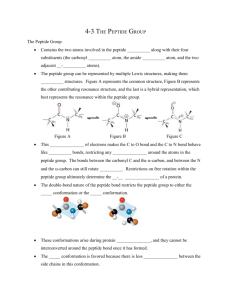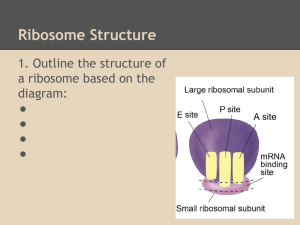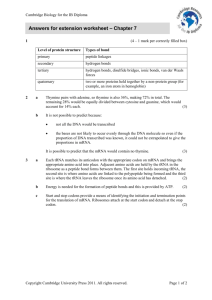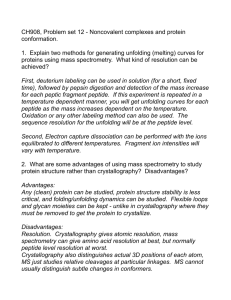LECT36 trans2
advertisement
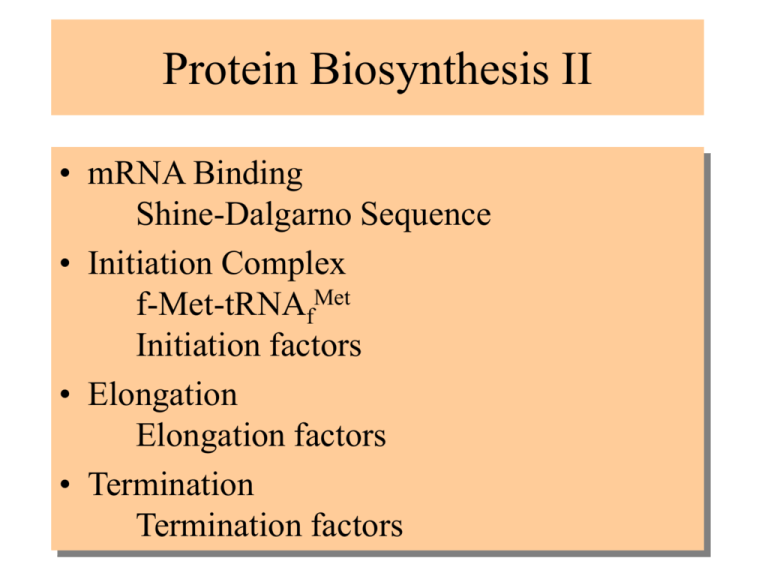
Protein Biosynthesis II • mRNA Binding Shine-Dalgarno Sequence • Initiation Complex f-Met-tRNAfMet Initiation factors • Elongation Elongation factors • Termination Termination factors Dintzis Experiment 3H-Leucine H2NH2N- 5’ 3’ 3H C-terminal is richer in radioactive 3H-leucine Product analysis 60 min Trypsin COO- 8 min H2N- COO- 4 min Released Protein N C-terminal H2N- Shine-Dalgarno Purine-rich mRNA Pyrimidine-rich rRNA complementary fMet-tRNAfMet H CH3-S-CH2CH2C-COO-tRNA N-H C=O H N-Terminal Block Blocking the N-terminal amino acid assures that the peptide chain will grow towards the C-terminal Vocabulary of Terms • Aminoacyl-tRNA: tRNA with an amino acid attached • Peptidyl-tRNA: tRNA with peptide attached • Nascent chain: peptide chain in act of being assembled • P-site: Site on ribosome where peptidyl-tRNA sits • A-site: Site on ribosome where incoming aminoacyl-tRNA binds • Peptidyl transferase: Enzyme that forms peptide bond OVERALL MECHANISM Protein Biosynthesis takes place on Ribosomes Picture the ribosomes as an assembly site and a ratchet machine GTP, not ATP, is the fuel that drives the machine tRNAS are brought to the assemble site called the “A” site A peptide bond is formed by transferring the peptide from the P site to the N-terminal of the new amino acid (aminoacyl-tRNA) (OVERALL CONT.) The peptide now has the new amino acid in the C-terminal…still attached to the tRNA The peptidyl tRNA is in the A site The mRNA with the peptidyl-tRNA attached shifts one frame bringing a new codon into the A site Simultaneously, the peptidyl tRNA is pushed into the P site and the uncharged tRNA is shoved into the E site and expelled INITIATION 1. The machine is disassembled into its component parts to allow the mRNA to bind 2. The starting tRNA is set into position 3. The larger 50S subunit is put back in place Initiation Complex Elongation 1. Peptidyl-tRNA sits in the P site 2. An aminoacyl-tRNA reacts with elongation factor EF-Tu in preparation for binding to the A site. 3. A-site binding occurs as GTP is hydrolyzed. EF-Ts removes spent GDP. 4. A peptide bond is formed with the transfer of the peptide from the P site to the A site 5. Elongation factor EF-G shifts the mRNA one frame, expelling the uncharged tRNA Elongation Termination 1. Translocation results in a stop codon (UAA, UGA, UAG) in the A site 2. A termination factor that recognizes the codon binds to the A site 3. The peptide in the P site is transferred to the factor 4. Because the factor cannot bind, the peptide is released Termination COOH Diphtheria Toxin (Cornyebacterium diphtheria with bacteriophage cornyephage ) 1. Reacts with elongation factor eEF-2 (prokaryote G) eEF-2 + NAD+ NH2 N N O N N O O-P-O-P-O CH2 N O CH2 O O O HO Diphtheria toxin CONH2 OH Modified His in eEF-2 is target HO s + Break glycosidic bond to nicotinamide in reaction s PEPTIDECHAIN N N CH2 CH2 CH NAD+ C= O eEf-2 s PEPTIDECHAIN + N(CH3)3 N ADP CH2 N O NH2 + N(CH3)3 A (catalytically active) B (cell penetration) CH2 CH2 CH C= O HO OH (diphthamide group) Trypsin s OH NH2 ADP ribosylation A s s B Endocytosis Receptor s s A H s B Disulfide cleavage H s Active enzyme A NAD+ eEF-2 ADP-ribosyl-eEF-2 (ribosylates histidine residues with diphthamide structure) (See p 879) Translation Blocking Antibiotics Puromycin Binds to A site and receives peptide from transpeptidase Aborts peptide prematurely Prokaryotes and eukaryotes Blocks peptidyl transferase in prokaryotes (A-site binding) Aminoglycoside Causes misreading and inhibits chain initiation of prokaryote mRNA Inhibits aminoacyl-tRNA binding to prokaryotes: blocks nutritional factor ppGpp (p867) Post-translational Processing • Folding • Proteolytic processing • Additions to peptide chain Carbohydrates (glycosylation) Methyl groups Lipid groups Hydroxylation, deamination • Secretion Folding Rule: Proteins must fold to an active conformation. Generally, folding is spontaneous as the protein seeks its lowest energy level Rule: Cells have “chaperones” that assist in proper folding. Typical are Hsp70 and Hsp60 Stepwise Random Chain Secondary helix or sheet Hydrophobic alignments Compact folded protein Proteolytic Processing of Insulin Preproinsulin Proinsulin Insulin Disulfide bonds s s s s B chain s s s s A chain


